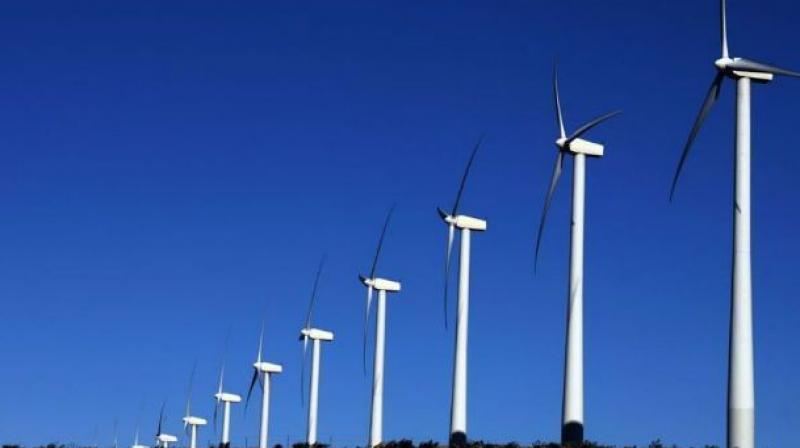India's Renewable Energy Capacity Hits New Milestone: Centre

New Delhi: India has reached a significant milestone in its renewable energy journey, with the country's total renewable energy capacity crossing the 200 GW (gigawatt). This remarkable growth aligns with the country's ambitious renewable energy target of achieving 500 GW from non-fossil sources by 2030.
According to the Central Electricity Authority, the total renewable energy-based electricity generation capacity now stands at 203.18 GW. This achievement underscores India's growing commitment to clean energy and its progress in building a greener future. India's total renewable energy installed capacity surged by an impressive 24.2 GW (13.5%) in just one year, reaching 203.18 GW in October 2024, up from 178.98 GW in October 2023.
Additionally, when including nuclear energy, India's total non-fossil fuel capacity rose to 211.36 GW in 2024, compared to 186.46 GW in 2023.
This milestone reflects the result of years of dedicated efforts to harness India’s natural resources. From sprawling solar parks to wind farms and hydroelectric projects, the country has steadily built a diverse renewable energy base. These initiatives have not only reduced reliance on fossil fuels but also strengthened the nation’s energy security.
When factoring in the 8,180 MW (megawatt) of nuclear capacity, the total non-fossil fuel-based power now accounts for almost half of the country's installed electricity generation capacity, signalling a strong move toward clean energy leadership on the global stage.
India's total electricity generation capacity has reached 452.69 GW, with renewable energy contributing a significant portion of the overall power mix. As of October 2024, renewable energy-based electricity generation capacity stands at 203.18 GW, accounting for more than 46.3 percent of the country's total installed capacity.
This marks a major shift in India’s energy landscape, reflecting the country’s growing reliance on cleaner, non-fossil fuel-based energy sources. A variety of renewable energy resources contribute to this impressive figure. Solar power leads the way with 92.12 GW, playing a crucial role in India’s efforts to harness its abundant sunlight. Wind power follows closely with 47.72 GW, driven by the vast potential of the coastal and inland wind corridors across the country. Hydroelectric power is another key contributor, with large hydro projects generating 46.93 GW and small hydro power adding 5.07 GW, offering a reliable and sustainable source of energy from India’s rivers and water systems.
Biopower, including biomass and biogas energy, adds another 11.32 GW to the renewable energy mix. These bioenergy projects are vital for utilizing agricultural waste and other organic materials to generate power, further diversifying India’s clean energy sources. Together, these renewable resources are helping the country reduce its dependence on traditional fossil fuels, while driving progress toward a more sustainable and resilient energy future.
In 2023, India's renewable energy sector reached a significant milestone, with an estimated 1.02 million jobs created, according to the International Renewable Energy Agency's (IRENA) 2024 Annual Review. The global renewable energy workforce expanded to 16.2 million in 2023, up from 13.7 million in 2022, with India playing a significant role in this growth. The report, created in collaboration with the International Labour Organization (ILO), underscores India's increasing leadership in clean energy and its commitment to generating green jobs that fuel economic growth.
Hydropower emerged as the largest employer within the sector, providing around 453,000 jobs, which accounted for 20 per cent of the global total, second only to China. The solar photovoltaic (PV) sector followed closely, employing approximately 318,600 people across both on-grid and off-grid systems. In 2023, India added 9.7 GW of solar PV capacity, ranking fifth globally for new installations and cumulative capacity, which reached 72.7 GW by the end of the year. Of the total solar workforce, 238,000 jobs were in grid-connected solar PV, reflecting an 18 per cent increase from 2022, while around 80,000 individuals worked in the off-grid solar sector.
The wind sector employed about 52,200 people, with nearly 40 per cent of these jobs in operations and maintenance and 35 per cent in construction and installation. Other renewable energy subsectors also contributed to job creation, with liquid biofuels providing 35,000 jobs, solid biomass contributing 58,000 jobs, and biogas generating 85,000 jobs. Additionally, the solar heating and cooling sector employed 17,000 people, highlighting the diverse and expanding employment opportunities within India's renewable energy industry.

